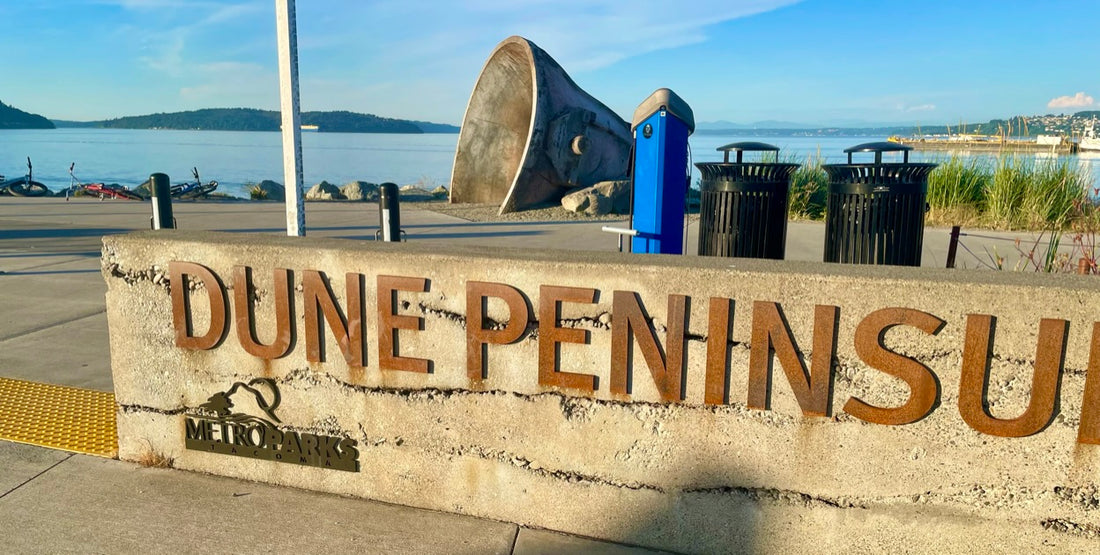Frank Herbert, author of the Dune Trilogy, was born & raised in Tacoma. His novels about environmental reclamation have been honored as part of the creation of our neighborhood, which, in turn, has been created from the environmental degradation of the Asarco copper smelter. After a quarter-century being an EPA Superfund site, the development of Point Ruston… our “village”… we believe has been properly cleaned up. Indeed, we trust… with our health & our fortune… that it has been!
I read & quite enjoyed those Dune books, back in my Sedona years, when I was reading much more science fiction & fantasy than I currently do. So I genuinely appreciate the symbolism of the environmental resuscitation of this site.
I discovered this short well-made video which tells more of the story:
The photo below shows the sign at the entrance, although we walk from home along the path to the right… it’s a bit of an intersection offering a bright blue free DIY bicycle repair stand with tools available on chains & a manual tire pump. Two nearby waste containers, although necessary, clog the shot I would wish for: an unimpeded view of a huge crucible from the smelter overlooking the waters up the Sound. The image nonetheless tells multiple stories about the place.
This map focuses the layout of the Dune Peninsula.
From the far heights of the peninsula, we can watch the ferry to Vashon Island arrive & depart, as we meander around its tip above the boat houses & the Tacoma Yacht Club. Or, we might continue along the pedestrian bridge over the roadway directly into Point Defiance Park, which has multiple gardens, a beach, zoo & aquarium inside hundreds of acres of woods. Our condo is just beyond the lower right corner of the map, along the Water Walk which continues for several miles back up towards the city.
Often lately we have been drawn on our daily walks to head for this Dune destination, appreciating the concept & design of this park. The terrain is sculpted from capped piles of polluted soils, intersecting spathes & stone-work.
The signage in this park is quite informative. I’ll let it do some of my work to tell the story of the relation ship of the remediation of the site with the author for which it is named:


Not all details are without some of my critique, of course, but I celebrate most of it… particularly the bronze plaques with quotes from the Dune books embedded along the walkway.







There is a boulder hollowed by a shallow basin atop one of three significant pyramidal piles, referencing the lack, thus intense conservation, of water on the desert planet fantasized by Herbert. While this site is nearly surrounded by sea water, it includes huge vistas of Puget Sound; we too are conscious of the need to conserve that essential resource.
A bronze sculpture of a baby “sand worm” (the mode of transportation in the books) seems to surface, dive & writhe atop another stone pile terraced with rock into very steep, very tall, steps climbing the front side, increasing a daunting illusion referencing archetypal temples. Youthful energies can scramble up & down those. Folk with more limited capabilities, or “souls of a certain age” like me, can reach the same height, using a gentle gravel path easing up the back side. we’ve met some with walkers there… even in wheelchairs!
Much of conceptual design of this park must have been incubated over many years, inside a very raw vision of the terrain while it was worked by heavy machinery to collect, isolate, & cap the tons of polluted debris into new existence as this park of imaginary terrain… a useful teaching tool for our wasteful culture.
I suspect few of the artists & designers could properly conceive of the site’s ultimate scale. Thus the sand worm seems a bit too small, almost invisible from some vantage points. My imagination as I read the books pictured the behemoths ridden by skillful characters riding & guiding them with big hooks. Still, the sculpture, labeled as a “baby”, illustrates the story nicely.



A third dune has a zig-zag retaining wall between one of numerous grassy slopes. Its rocky pyramidal steps are topped with a collection of young pines, which I assume will take on interesting shapes over future years in the weathering winds of the turbulent channel leading towards the Tacoma Narrows Bridge(s). The history of bridging that gap is a “Galloping Gertie” story for a future post…

Walking home (at the far end of this row of buildings) we are greeted by our lovely, if often elusive, mother mountain!
Even so, her elusiveness can be quite ethereally dramatic!




